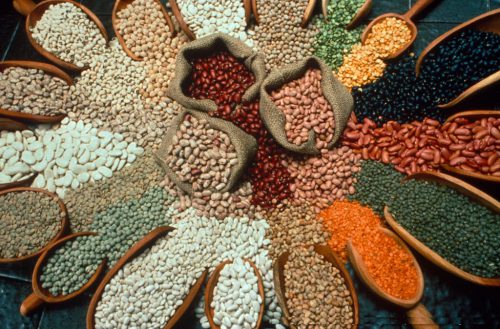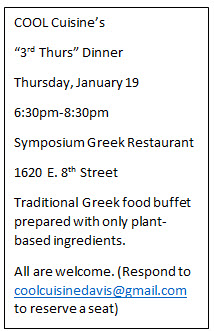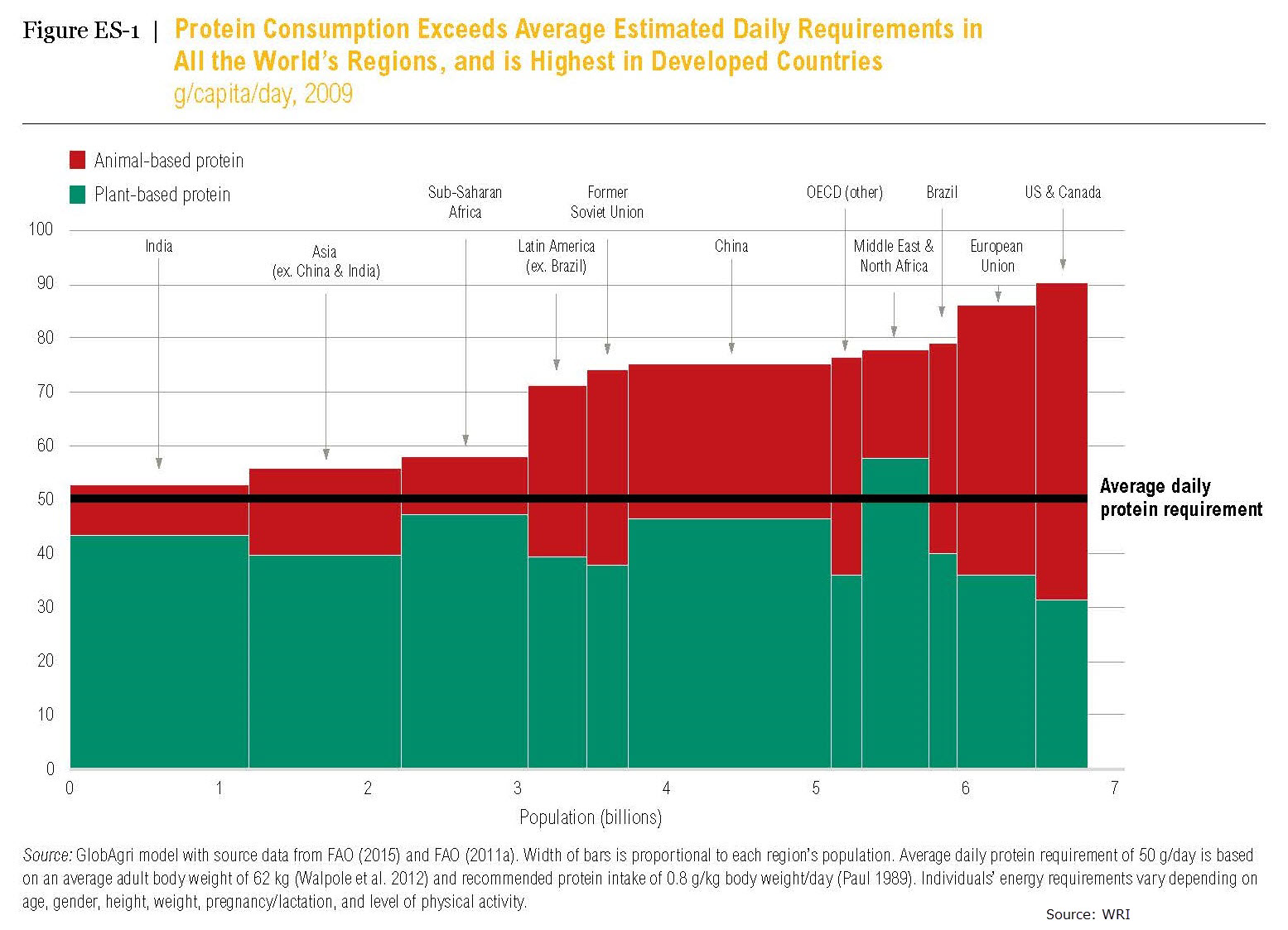 By Anya McCann, COOL Cuisine
By Anya McCann, COOL Cuisine
Have you heard? The livestock sector produces about 15% of global greenhouse gases, roughly equivalent to all the exhaust emissions of every car, train, ship and aircraft on the planet.
On January 8 the Phoenix Coalition held the most recent installment of their Davis Community Gatherings with the subject “Climate and Environmental Justice.” I was invited to lead a discussion group related to food, climate change, and environmental justice (EJ).
I participate in the #1 most impactful action any single person can take to combat global climate change: I eat a diet free of any animal products. It is my mission in Davis to enable those who eat meat to easily make different choices in at least some of their meals.
Some simple-to-understand goals were outlined in the World Resources Institute (WRI) 2016 Working Paper “Shifting Diets for a Sustainable Food Future.” (Synopsis here.) Sustainability includes concerns for climate change and “the fact that the world needs to close a 70 percent ‘food gap’ between the crop calories available in 2006 and expected calorie demand in 2050.” Calorie demand will be driven by population growth and by raising standards of living—when humans are wealthier, they eat more. WRI goals are:
- Reduce overconsumption of calories.
- Reduce overconsumption of protein by reducing consumption of animal-based foods.
- Reduce consumption of beef specifically.
Let’s examine these recommendations.
- Reduce Calories
On the planet there are 2 ½ times more overweight people than undernourished. We have many options of foods to eat and, especially in the U.S., we feel entitled to eat whatever we want with no  boundaries. The fact that some people eat more calories than they require to maintain good health creates a food system that widens the gap between the haves and have nots.
boundaries. The fact that some people eat more calories than they require to maintain good health creates a food system that widens the gap between the haves and have nots.
It drives expanding agriculture that is not really needed and therefore increases environmental impacts. (In addition obesity had a worldwide economic cost of $2 trillion in 2012.)
- Reduce Animal-Sourced Protein
The global consumption of protein is one-third higher than the average established need for an adult and it is highest in the U.S. (Hands down, the #1 most annoying question omnivores ask vegetarians and vegans is: “Where do you get your protein?”)
This graph from WRI demonstrates on average Americans almost meet our daily need from the consumption of plant proteins alone, while most of the protein we over-eat is derived from animals. According to WRI “The agricultural land use and greenhouse gas emissions associated with the average American diet were nearly double those associated with the average world diet, with 80 to 90% of the impacts from consumption of animal-based foods.” Under the new Recommended Dietary Allowance (RDA) guidelines for women I only need 40 grams…meeting that is so easy that I have stopped keeping a tally in my head. Can you think of one person you know who ate three meals a day and was diagnosed as protein deficient in the U.S.?

The upshot is that WRI recommends if everyone in high-consumption areas (the U.S.) reduced their intake of animal-sourced protein to 60 grams, global animal-based protein consumption was reduced by 17 % we could meet global climate change goals and adequately feed the world by 2050.
You don’t have to eat none, just eat less.
- Reduce Beef Consumption
According to WRI beef is by far the least efficiently produced animal protein from a “feed input to food output” view. Only 1 percent of the feed cattle consume is converted to calories that people consume from eating beef. In addition, “Nearly half of the agricultural land use and greenhouse gas emissions associated with supplying the average American diet stemmed from beef alone.” In the ambitious beef reduction scenario explored by WRI, in order to bring diets in America to the world average, Americans would need to reduce their intake of cows by 70%. This frees up one-third of agricultural land and reduces animal agriculture GHGs by 35%.
Note that there is a large projected growth in beef consumption as world incomes rise, so making these changes would contribute to basically keeping land use and GHGs at a level demand, not an actual reduction.
Strategies
WRI suggests there are many strategies we need to employ to shift eating styles and consumption patterns. The first is an evolution of social norms about our food choices. We need to raise awareness of the impacts and make this goal socially desirable while making overconsumption socially unacceptable.
They encourage minimizing disruption in people’s lives by disguising changes (what my mother used to call “hiding” ingredients we did not like into a different, unrecognized form—like putting a layer of spinach in lasagna) and to replicate the experience of eating animal products to which people are accustomed.
There are at least eight refrigerated/frozen cases in the Davis Food Coop filled with these great tasting products—plant based version of cheese, milk, sausages, ground beef, hot dogs, deli slices, burgers, chicken wings, bacon, yogurt, cream cheese, mayo, sour cream, and more. We are in a heavenly period for “fake” products compared to even ten years ago. They make it easier to transition your diet. And so many more people are purchasing them that they are now at very reasonable prices.
Environmental Justice
The subject of costs takes me back to the Phoenix Coalition workshop and their EJ goal. We were instructed to provide actions participants can take toward reducing GHG emissions and providing climate justice. How do we help low-income members of our community eat more plants? Over 35,000 people in Yolo County are food insecure. I suggested two organizations that provide fresh, local fruit and vegetables to the needy in our area.
FARM Davis is wonderful alternative form of civic action, building community through sustainable farming of public and private space, assisting low-income and homeless populations, and integrating local and real food (vegetables and fruit) into mainstream culture and education. They need volunteers to come to work days to plant, tend to, or harvest food in several locations, help driving food to where it goes, and cash donations to keep things running.
Community Harvest of Davis is another locally run volunteer group that harvests the fruit from trees in residents’ yards which they do not plan to pick or eat and provides it to Yolo Food Bank and STEAC to supply area food pantries. They pick 30,000 lbs. of fruit each year (at $1.25 per lb. for say oranges, those volunteers provide $37,500 of food with minimal volunteer time.) It is amazing. (Contact Joe Schwartz at jlschwar@pacbell.net )
Eating Plant-Based Together
COOL Cuisine (for a cooler planet) members want more places to go out to eat that serve plant-based dishes. Guests at our events eat less animal products for the planet, for their health, or out of compassion for animals…or all three. We take action by joining for social, fun gatherings at a different restaurant each month on the 3rd Thursday to vote with our wallets. You can find us on Facebook or Meetup.com. Our website has a list of restaurants we went to last year that have at least three meals worth of items on their menu. In 2017 we are planning events at restaurants willing to improve their selection of choices and mark their menus more clearly. January 19th, 3rd Thurs will be held at Symposium Greek restaurant, 6:30 pm at 1620 E. 8th Street.
If you are looking for support, guidance about products, recipes, cooking tips and more, sign up on Facebook for the Vegans of Davis chat group. UC Davis Integrative Medicine has a 21 day program for eating a healthy, plant based diet with guidance, support, and recipes. The organization Vegan Outreach has a mentor program you can sign up for. And you can contact me at coolcuisinedavis@gmail.com and I will be glad to provide resources for whatever level you are at in the process of eating less animal products.





I can see a new terms coming our way soon:
Food privilege
Beef privilege
Fat shaming?
“The fact that some people eat more calories than they require to maintain good health creates a food system that widens the gap between the haves and have nots.”
I think you’re trivializing an important point about the unequal distribution of food in the world that leads to some overconsuming while others are literally starving to death.
Keith
After giving your post a fair amount of thought, I cannot tell if you are being honest, or sarcastic.
Do you not believe that having so much food that we are estimated to throw away as a society approximately 40 % of what is available while others die of starvation does indeed constitute “privilege” ?
“Fat shaming”. Anya’s article has absolutely nothing to do with fat shaming. How is a suggestion that there are healthier ways to eat that are less destructive of our natural resources combined with positive alternatives, the equivalent of “shaming” anyone in your mind ?
Anya
Thanks for the article. I am very supportive of your overall message and glad that you are so proactive in its promotion. I have just a couple of supplemental thoughts.
“On the planet there are 2 ½ times more overweight people than undernourished”
From a doctor’s point of view, this is an oversimplification that can lead to unnecessary push back. It is entirely possible to be both overweight and undernourished. This is indeed the metabolic situation for many Type II diabetics who have a diet that is rich in “empty calories” ( as exemplified by soda consumption) while remarkably devoid of foods with real nutritional value.
“Hands down, the #1 most annoying question omnivores ask vegetarians and vegans is: “Where do you get your protein?”)”
Rather than meeting this question with ‘annoyance” which almost invariably shows, I would encourage attempting to adopt an attitude of appreciation for the opportunity to reframe the issue. Omnivores do not ask this question out of stupidity, but rather out of ignorance. Although the education has been slowly improving, most Americans are still being given a meat ( or fish) serving as the example of protein on the plates shown as examples of healthy eating proportions. With the ubiquitous provision of meat as the example of protein, is it not to be expected that the majority of our population will have learned that it is the primary and best source ? What an opportunity to educate about the wide variety of foods that contain protein suitable for human consumption.
Tia, thanks for reading and being open to this shift in view about protecting our planet. The “overweight/undernourished” is directly from the WRI report. They chose calories as the most common measuring stick. I completely agree with your excellent point about empty calories and lack of nutrition. This is a multi-layered issue and WRI provides different recommendations for low incomes (too many details for one article).
Some people with low incomes eat mostly fast food and convenience foods. Reasons can include: in the short term it is less expensive, because there are addictive properties to these foods, and because they have no kitchen in which to cook fresh meals.
Supporting FARM and Community Harvest are great ways to provide access to fresh, nutritious foods. In disheartening discussions I have had with Robyn Waxman (FARM) about “ugly produce” I learned that among Davis’ low income and homeless populations people will not eat fruit and vegetables that do not look perfect (as bred for shipping/display) because they are afraid it might be bad and make them sick (and they cannot afford to go to the doctor). Addressing this fear requires a lot of repetition.
Nutrition is not taught in schools to the poor or the wealthy. Our food culture is shaped by manipulative marketing messages. But making better food options easily available and cheaper would be a start to a healthier world. Many people never evaluate food lobby messages (“milk does a body good”). We take them as gospel because once upon a time we had trust in our government to protect us. (A 1950s hangover which is quickly eroding this year.)
I encourage people to challenge the “facts”. It is difficult to suss out good research from bad, even with an advanced degree. I was quite surprised to learn that I have been overshooting the protein goal by 25-35 grams per day most of my life. I have more energy when I eat at the new RDA.
Point taken about the protein comment. There are thousands of memes about the protein question because it is the justification given for not eating “less” animal products. Food is tied to primal fears about scarcity. People generally do not think at all about what they put in their mouths and feel uncomfortable when asked to do so. I hope that these studies convince people that their lives are not in jeopardy if they increase fruit and vegetables to take the place of some of the animal protein. By just shift the balance a little, every person can make an excellent personal contribution to reducing global warming.
We need more community gardens and need to expand the programs for gardening in the public schools. It’s one of the simplest ways to teach nutrition and to get people past the ‘ugly produce’ syndrome.
I’ve hired a lot of young adults over the years who are relatively low income, and we have a lot of conversations about food and cooking. There is very little education about how to feed yourself and eat well — it’s the kind of life skill that has apparently fallen by the wayside in our schools. Many of them have had no idea how to maintain a well-stocked kitchen larder that would allow them to make meals economically. Fast food is very cheap, a very low cost per calorie.
Because we are selling food plants they generally develop a real interest in the subject, and it’s a simple hands-on way to feed yourself better. I’d like to see the classes that we used to call ‘home economics’ expanded and taught at every grade level, with more advanced versions for students who show an aptitude and interest (very marketable skills). Everyone should know how to make sauce, bake bread, cook vegetables, and preserve fruit. Heck, teach them how to make beer. I’m sure it’s one of the food groups.
Don, I could not agree with you more. Many basic life skills have fallen by the wayside with the demise of “shop” classes and home economics. Our Davis Farm to School program had a successful program of food tasting in cafeteria lines–encouraging kids to try a new vegetable or fruit before choosing what to put on their plate. But many school cafeterias try to make a sudden shift to healthier foods only to lose money because they need a transition and education period for children. Several parents have asked my advice this year because finding plant-based foods in our schools is difficult and unpredictably available. There are cooking skills classes for all ages at the Coop, but they may not be affordable. I’m not sure what they do on the UCD campus…there used to be interns who wandered around the dining halls giving education on sustainability and encouraging exploration in food choices. Learning to love the tastes of different foods and to be adventuresome takes repeat exposure. And your employees are lucky to have a guiding, supportive hand. Many adults I meet live on restaurant food and I always feel sorry they are missing out.
The success of animal agriculture in this country is one of the worst examples of the power of propaganda and lobbying. It is a travesty that the meat and dairy lobbyists have convinced the country that meat is good for them, when we know from medical studies (from Harvard, the World Health Organization, etc) that the opposite is true. These industries are making us sick from our food, polluting our water resources, causing illness in low income communities where they literally spray shit into the air, destroying our climate, forcing small farmers out of jobs, abusing workers, and killing billions of animals each year. No one benefits from the animal agriculture industry except for the big wigs in charge. If you thought that animal farming was about health, about supporting small farmers, or about the workers, think again. It is about money. We need to stand together as a community and protect public health and the environment. Thank you, Anya for pointing out the truth about meat and climate change.